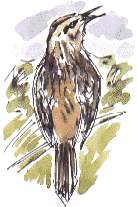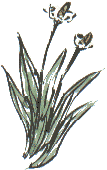

Sedge WarblerTuesday 30th May 2000  A SEDGE WARBLER performs its varied song from a Hawthorn at the edge of the rushy field between the canal and the river. A male Reed Bunting flies over and perches in the same bush. The raucous rush of the warbler's song reminds me of the patter of a stand-up comic with a bit of this and a bit of that. It flies over to the rushes, sings amongst them, then gives a little of the song in a short arching flight, rising just above the rushes. We get a better view of a second warbler that is singing from the reeds at the other side of the field. It has a conspicuous creamy eye-stripe, so I presume this too is a sedge. But, when I look for the streaks on its back, I can't make them out. Perhaps it's the angle I'm seeing it from, or perhaps this is another species. The streakiness is one of the differences between this and the plainer Reed Warbler.
          On our garden shed, the Dunnock chicks, two of them as far as we could see, must have flown the nest yesterday or this morning. There are still three turquoise eggs in the moss-lined nest. We have had some cool weather recently so perhaps this is why they failed to hatch.
On our garden shed, the Dunnock chicks, two of them as far as we could see, must have flown the nest yesterday or this morning. There are still three turquoise eggs in the moss-lined nest. We have had some cool weather recently so perhaps this is why they failed to hatch.
The Garden Path The back garden path is almost a wildlife habitat in itself now. I weed out grass, Creeping Thistle, Bush Vetch, Ribwort Plantain, a couple of Dandelions and Creeping Buttercup between the pond and the shed. It's well overdue for attention. I decide to go for wood chip, laid in a two inch layer over a sheet of black plastic. The path has log roll edging.
The back garden path is almost a wildlife habitat in itself now. I weed out grass, Creeping Thistle, Bush Vetch, Ribwort Plantain, a couple of Dandelions and Creeping Buttercup between the pond and the shed. It's well overdue for attention. I decide to go for wood chip, laid in a two inch layer over a sheet of black plastic. The path has log roll edging.I like its the soft natural look of wood chip. Gravel would look good too, but it's noisy, not as springy, to walk on. Besides, gravel is a non-biodegradable and non-renewable resource. Gravel extraction can have an effect on wildlife habitat. For example the rushy field with its warblers and wildfowl was ear-marked for sand and gravel extraction over fifty years ago, just after the war, when wildlife and landscape took second place to the efforts to rebuild the country. Letting a planning consent stand for over fifty years without any public discussion of its relevance may seem unusual, but, in a strange ceremony, a single bucket of gravel was extracted from the field some years ago, and so the consent was renewed. We've now got so many boating lakes, fishing lakes and nature reserves based around flooded gravel pits that habitats like this are all the more valuable. The wood chip is a by-product of the timberyard at the top end of the valley, which uses locally grown timber.
|
 After the rain, the patch of open water has reappeared amongst the rushes. The hawthorns are still in full blossom here, the Dog Rose is just starting to flower. Drifts of buttercups, with a sprinkling of Cuckoo Flower, surround the marsh.
After the rain, the patch of open water has reappeared amongst the rushes. The hawthorns are still in full blossom here, the Dog Rose is just starting to flower. Drifts of buttercups, with a sprinkling of Cuckoo Flower, surround the marsh.